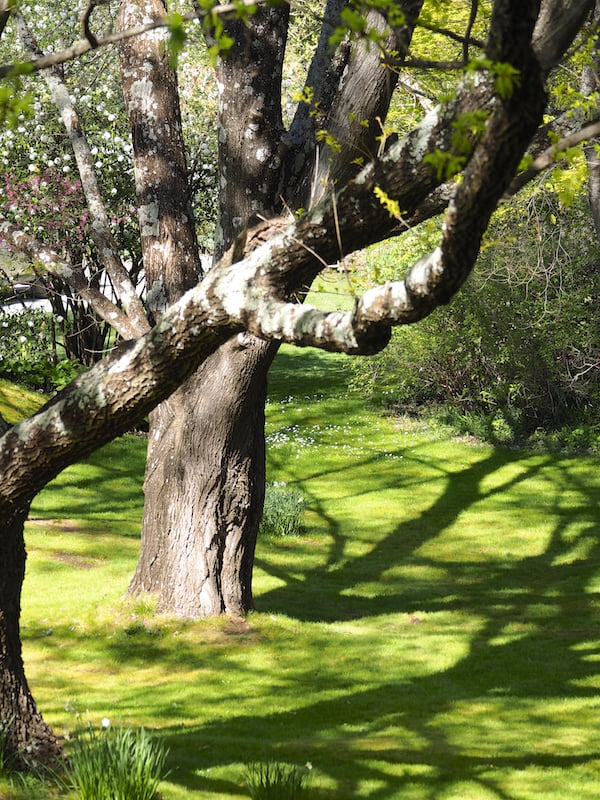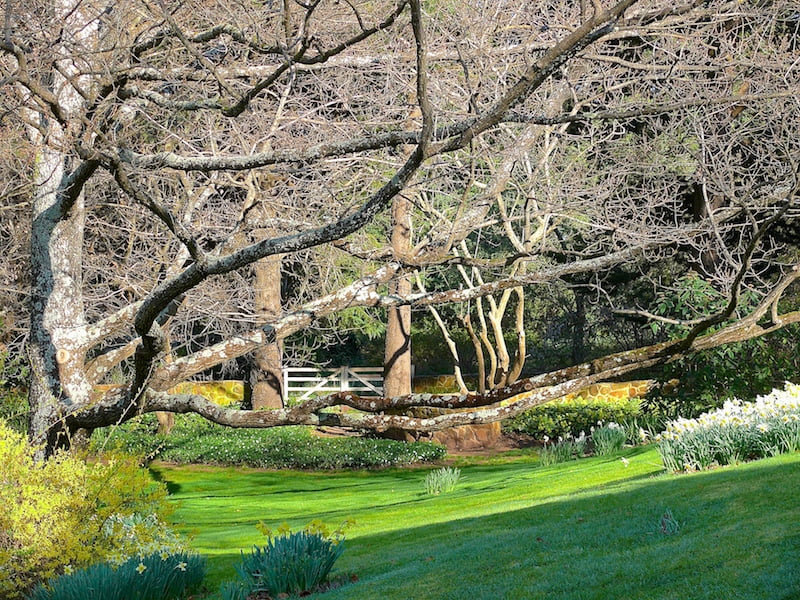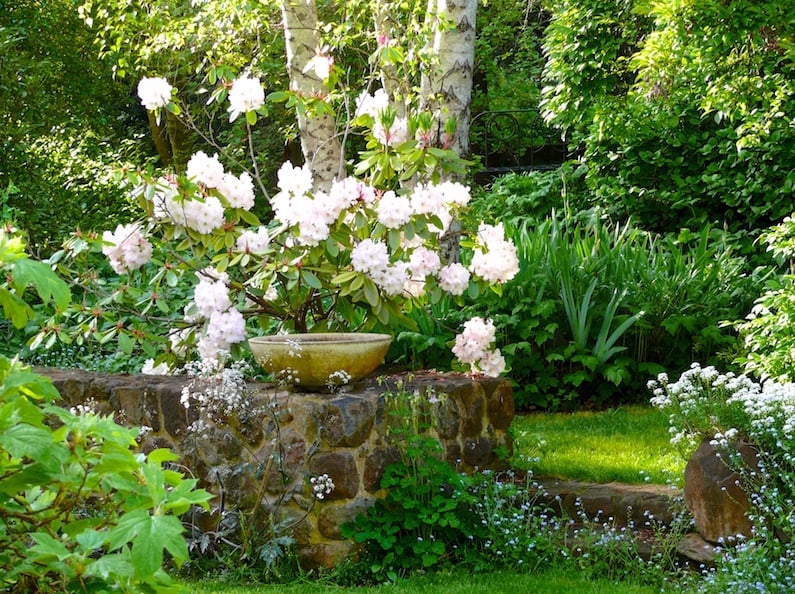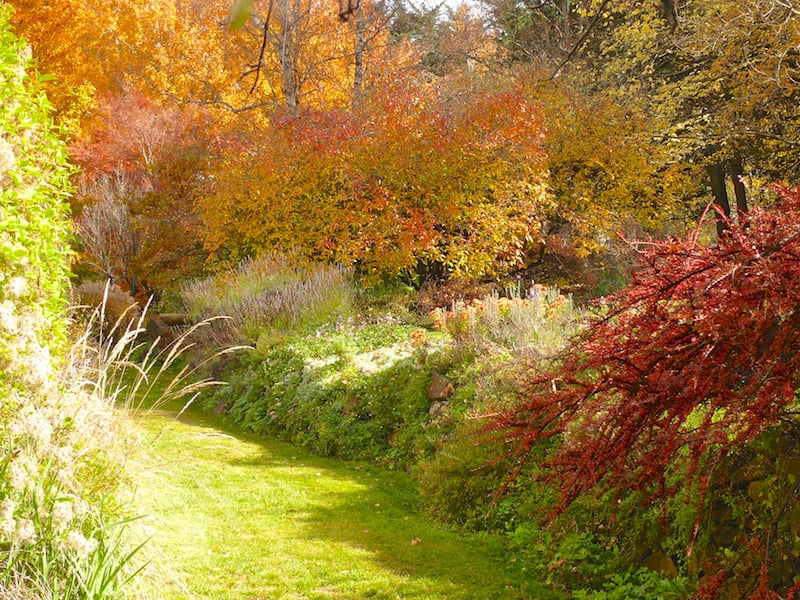How relevant is Edna Walling today? Have her design philosophies delivered all she espoused, or have her followers moved on? Thirty-four years of living in Kiloren, a 1951 Walling-designed garden in Crookwell, on the Southern Tablelands of NSW, probably gives us a little edge in responding to this vexing question. I say vexing because, when we purchased our beloved garden in 1982, everyone (even on the edge of gardening circles) knew of Edna: ‘You live in an Edna Walling garden? How wonderful!’.
Yes, in case you’re wondering, it is still wonderful. And yes, Kiloren still carries many Walling trademarks. Every day, even those down and dirty, rip-into-the-garden days, is a joy. It’s the peace and tranquility we most love. At the moment as I write, in December, spring is finally done and the garden is more green than floral. But tall blue campanulas now drift elegantly along the retaining wall, and the huge oak leaf hydrangea, English lavender and crisp white shastas are in bloom.

The dry stone retaining wall to the north of the house with its exuberant summer flowering of campanula, lavender, santolina, hypericum and veronica
What is it about this garden that makes us continue to respect, admire and value Edna Walling after more than three decades?
It’s hot and suddenly dry now, but this 4 acre garden has its own microclimate. In summer, it’s degrees cooler than the paddocks and little town outside its boundaries. Walling was often accused of planting too closely (she would refer her critics to the way trees and shrubs grew in the bush) but even on the hottest of days we find ourselves drawn to walk in the beautiful dappled light and shade she created in Kiloren’s woodlands and pathways overhung with foliage.

Walling wrote often about the importance of light and shade and in her original woodland, Kiloren’s 60 year old trees now create delicate patterns and cool spaces in summer.

The woodland springs to life in early spring with bulbs and early-flowering shrubs. English oak branches hug the hill and frame the gate leading to the wild garden
Kiloren is one of Edna Walling’s most informal gardens. The majority of her designs – especially in Victoria – combined symmetrical formality with a wilder, more relaxed area within each garden. Kiloren’s extensive walls of local basalt are not formal, but they still provide the architectural structure Walling included in each of her designs. She wrote that gardens without architecture were quickly lost, and when researching the two books on Edna Walling I co-authored with Trisha Dixon, we both discovered ‘lost’ Walling gardens. Beneath years of neglect and fallen debris, we could grab a rake and rediscover the pathways, walls and steps that featured in her original design – quiescent and waiting for someone to treasure them again.

Kiloren’s stone walls lend important structure to its informal design. Other Walling trademarks here include relaxed planting softening the stonework, the simple steps effecting a small change in level and multi-stemmed silver birch (Walling occasionally dismayed clients by cutting well-grown single trunked birches to the ground to achieve this effect)
Crookwell has a cold climate with four distinct seasons and Kiloren sits at 950 metres above sea level. In winter, when exuberant spring and summer herbaceous perennials are hibernating, Walling’s superbly proportioned stonework holds the design together and gives us enormous pleasure as we look out onto the frosty, pared-back landscape.

Later in spring Walling’s favourite Lavendula stoechas jostles for space with aquilegias, Deutzia nikko, and old-fashioned ground covers such as snow-in-summer.

Autumn is the softest time of the year and Kiloren’s walls almost disappear under profuse growth. By winter, the stonework once again dominates and anchors the view from the house.
We take delight in sending open day visitors on a journey of discovery when they ask how to navigate Kiloren. ‘Does one, upon entering the gate, wonder which way to turn, all directions being enticing?,’ wrote Walling. On our regular walks, we ask ourselves the same question: ‘Which way will we go today?’. How special, after all these years, that there remains an air of mystery that invites us to explore Kiloren’s hidden corners. There’s always the hint of another path, or the next chair, or a stretch of lawn disappearing around a corner.
Perhaps it’s Walling’s planting philosophies that we’ve most followed. Perennials were – and still are – preferred to annuals (Walling was addressed as ‘Dear Anti-annual’ in one rather cranky letter), self-seeding encouraged, pruning kept to a minimum and ground covers coveted. We’re fortunate Kiloren is surrounded by grazed paddocks, protecting its surroundings from exotic escapees, but we still manage carefully forget-me-nots, aquilegias, honesty and other generous seeders for both environmental and aesthetic reasons.

Looking back from the wild garden across one of the newer walls, built in local basalt in the proportions Walling often used for rendered walls. Forget-me-nots drift among hellebores (H. orientalis and H. foetidus), tall cream tulips, Scilla and the strappy leaves of autumn-flowering colchicums.
Over the years, we’ve amassed an interesting plant collection. But how and where these plants are used, their relationship to other plants in the garden and their impact on the design intent, are more important considerations than creating a botanic garden. And I routinely practice repeat planting. I like to come across a drift of the same plant in different parts of the garden. It’s a little like creating a familiar, loved theme in a symphony.
I especially love Walling’s maxim that a framework of hardy, proven performers is essential, and only then do you weave in the rare plants, the jewels. Deutzia, forsythia, viburnums, ribes, kolkwitzia, choysia, philadelphus, abelia, japonica – these are the reliable shrubs in our garden that just keep on keeping on, never failing to deliver pleasure for weeks on end.

We love forsythia! From the house we enjoy its fresh yellow flowers for at least 4 weeks in early spring. This old-fashioned shrub is typical of the dependable performers Walling favoured
In many ways Walling was ahead of her time. Apart from her strong views on conservation, she wrote constantly about good watering practices as early as the 1920s. We’ve introduced grasses, sedums, salvias and other perennials like Russian sage – species that weren’t readily available in her time. I like to think Walling would have approved of these plants that perform well with minimal watering in our increasingly unpredictable climate. And she extolled what is now regarded as ‘new’ gardening – forget the tidying, leave finished flower stems and seed heads to give pleasure through autumn and winter. She wrote:
‘The early frosts make a fairyland of the garden where herbaceous perennial stems still remain …’
Walling also created for two keen bird watchers an avian heaven, so much so that the binoculars and zoom lens are always within reach. She wrote about gardens being ‘ …just a little too big to keep the whole cultivated, then it has a chance to go a little wild in spots …’. And to provide safe places for birds to nest and escape predators.
Right now we’re incredibly excited to be sharing the garden with a family of native wood ducks. The adults arrived with their eight tiny young fresh from the nest in late November and seem determined to stay. Two years ago we raised an orphaned two day old wood duck and saw her through to breaking the bonds and leaving with her wild friends. We wonder – and hope – that perhaps she’s come back to familiar surroundings to raise her family, back to Edna’s leafy, peaceful oasis.
Walling is still hugely relevant to us and to Kiloren – and, we hope, to future owners of the garden. She’s never been a burden and we don’t feel constrained, but we acknowledge it’s her wisdom and philosophies that have guided us as we’ve cared for Kiloren over the decades.

Aspens, a Walling favourite, overhang the wall separating Walling’s original design from the wild garden we’ve created.
Kiloren is now for sale – visit the garden’s website to learn more via the advertisement on this page. Edna Walling’s Crookwell garden has had only two owners since inception in 1951 and it is now waiting for its next custodians.
The last word belongs to an outside observer:
‘I often find gardens that I love. But I rarely find whole properties that I yearn to move into tomorrow… It almost never happens that everything comes together all at once in the same place, but its masterly creators and owners have meant that Kiloren is one such property.’
(Janna Schreier, landscape designer and GardenDrum contributor – read more at Janna’s blog).
What a joy to read. I envy the next custodian of this glorious and charming garden!
Thanks Catharine, so pleased you enjoyed the post. We should let people into the secret that you know Kiloren well … Jennie
Thank you ,Jennie. just thankyou,
And still relevant???? I just wish Edna could come and work her magic for me now…. But failing that I will continue use her perceptions and principles as a guiding light to make even the faintest approximation of the beauty which has & continues to give me , And obviously others, so much joy, deep , deep satisfaction, peace and contentment. She has left a great gift to us. Best wishes to all those who follow a different path , but it’s Edna for me !
Laurel
Dear Laurel, I have really enjoyed our previous communications, it’s encouraging and reassuring to find others who find value in Edna Walling’s wisdom and gardening philosophies. Good luck with your Queensland gardening, Jennie
Great article Jennie, good luck with the sale
Thank you Anne, pleased you enjoyed reading about Kiloren and thanks for the best wishes. It will be a huge wrench after 34 years, but because we still love our garden we will care for it until the day we leave – hopefully handing the keys and gardening tools to people who will love it as much as we do.